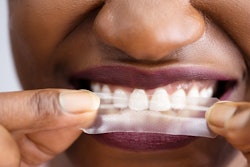
Giving patients ibuprofen plus potassium fluoride prior to in-office bleaching may be effective in reducing tooth sensitivity and pain, according to a study published on January 22 in the Journal of the American Dental Association.
However, using ibuprofen and potassium fluoride separately before tooth whitening was inconclusive, the authors wrote.
“It provides a superior analgesic effect,” wrote the authors, led by Dr. Raniel Peixoto, PhD, an adjunct professor with the department of restorative dentistry at the Federal University of Ceará in Brazil.
Easing the pain
Despite breakthroughs made in the field of teeth whitening, a standard protocol for reducing post-bleaching tooth sensitivity does not exist. It has been established that, when given preemptively, ibuprofen can reduce the inflammatory process generated by free radicals that reach the dental pulp. Desensitizing agent potassium fluoride 2% decreases the amount of peroxide that diffuses through dental tissues by sealing dentinal tubules.
Though teeth whitening sensitivity isn’t completely understood yet, the authors hypothesized that there is a synergistic effect involving the mechanisms of action of ibuprofen and potassium fluoride that may help cut tooth sensitivity.
To explore the analgesic effect of preemptively administered ibuprofen -- either alone or in combination with a 2% potassium fluoride -- on post-bleaching tooth sensitivity, a triple-blind, randomized, placebo-controlled clinical trial was completed with 15 patients. Researchers used a crossover design for drug administration and a split-mouth design for the desensitizer agent.
Patients were either given ibuprofen and potassium fluoride, ibuprofen and placebo potassium fluoride, placebo ibuprofen plus potassium fluoride, or placebo ibuprofen and potassium fluoride. Tooth sensitivity was measured using the visual analog scale, and data was collected at baseline and after six, 30, and 54 hours, according to the study.
Compared to the placebo group, 400 mg of ibuprofen in addition to 2% potassium fluoride appeared to be more effective in decreasing sensitivity after tooth whitening (p < .05). In the placebo group, the risk of experiencing moderate or severe tooth sensitivity was about four times higher than in patients who were given ibuprofen plus potassium fluoride (relative risk, 4.00; 95% confidence interval, 1.01 to 15.81; p = .025), the authors wrote.
However, preemptively using ibuprofen and potassium fluoride separately were inconclusive. Statistically, their results were like placebo, they wrote.
More to study
Nevertheless, the study had limitations, including that only one drug and bleaching agent were used at conventional levels, the authors wrote. In the future, new studies with varying drug and bleaching agents, as well as different concentrations, need to be completed, they wrote.
“The synergistic effect of the mechanisms of action of IBU (ibuprofen) and the desensitizer may justify the preemptive use of IBU plus KF2 (potassium fluoride 2%) in reducing levels of sensitivity to tooth bleaching,” Peixoto and colleagues wrote.




















